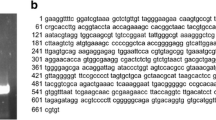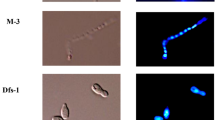Abstract
The performance of temperature-shift strategies on the production of α-amylase by Bacillus sp. in solid-state fermentation systems was investigated. Switching the temperature from an initial set point (37 °C, 40 °C, or 45 °C) to 28 °C increased the production of α-amylase significantly in all treatments, with different rates. The effects of having a constant incubation temperature and performing the temperature-shift operation from higher to lower temperatures (37 °C, 40 °C, or 45 °C) to 32 °C and vice versa were also studied. The results showed that the α-amylase biosynthesis could successfully be improved by shifting the incubation temperature from 40 °C for the initial 20 h of fermentation to 32 °C after a span of 20–48 h. An enhancement of 29.5% in the production of α-amylase after 48 h was recorded compared to the treatment that was shifted from 37 °C to 32 °C. This finding is particularly attractive for large-scale industrial fermentation from an economic point of view.




Similar content being viewed by others
References
Antoine, A. A., Jacqueline, D., & Thonart, P. (2010). Xylanase production by Penicillium canescens on soya oil cake in solid-state fermentation. Applied Biochemistry and Biotechnology, 160, 52–62.
AOAC. (2000). Official methods of analysis of AOAC International. Washington, DC: AOAC.
Bernfeld, P. (1955). Amylase α and β. Methods in Enzymology, 1, 149–158.
Bradford, M. M. (1976). A rapid and sensitive method for the quantitation of microgram quantities of protein utilizing the principle of protein-dye binding. Analytical Biochemistry, 72, 248–254.
Chutmanop, J., Chuichulcherm, S., Chisti, Y., & Srinophakun, P. (2008). Protease production by Aspergillus oryzae in solid-state fermentation using agroindustrial substrates. Journal of Chemical Technology and Biotechnology, 83, 1012–1018.
Eibes, G. M., Lú-Chau, T. A., Ruiz-Dueñas, F. J., Feijoo, G., Martínez, M. J., Martínez, A. T., et al. (2009). Effect of culture temperature on the heterologous expression of Pleurotus eryngii versatile peroxidase in Aspergillus hosts. Bioprocess and Biosystem Engineering, 32, 129–134.
Hashemi, M., Razavi, S. H., Shojaosadati, S. A., Mousavi, S. M., Khajeh, K., Safari, M. (2010). Development of a SSF process for production of an alpha amylase with potentially interesting properties. Journal of Bioscience and Bioengineering, 110(3), 333–337.
Lonsane, B. K., & Ramesh, M. V. (1990). Production of bacterial thermostable α-amylase by solid-state fermentation: A potential tool for achieving economy in enzyme production and starch hydrolysis. Advances in Applied Microbiology, 35, 1–56.
MacCabe, A. P., Orejas, M., Tamayo, E. N., Villanueva, A., & Ramón, D. (2002). Improving extracellar production of food use enzymes from Aspergillus nidulans. Journal of Biotechnology, 96, 43–54.
Pandey, A., Selvakumar, P., Soccol, C. R., & Nigam, P. (1999). Solid state fermentation for the production of industrial enzymes. Current Science, 77, 149–162.
Rajagopalan, G., & Krishnan, C. (2009). Optimization of agro-residual medium for α-amylase production from a hyper-producing Bacillus subtilis KCC103 in submerged fermentation. Journal of Chemical Technology and Biotechnology, 84, 618–625.
Ramesh, M. V., & Lonsane, B. K. (1987). Solid state fermentation for production of α-amylase by Bacillus megaterium 16 M. Biotechnology Letters, 9, 323–328.
Rivela, I., Rodríguez Couto, S., & Sanrom àn, A. (2000). Extracellular ligninolytic enzyme production by Phanerochaete chrysosporium in a new solid-state bioreactor. Biotechnology Letters, 22, 1443–1447.
Sajedi, R. H., Naderi-Manesh, H., Khajeh, K., Ahmadvand, R., Ranjbar, B., Asoodeh, A., & Moradian, F. (2005). A Ca-independent α-amylase that is active and stable at low pH from the Bacillus sp. KR-8104. Enzyme and Microbial Technology, 36, 666–671.
Sguarezi, C., Longo, C., Ceni, G., Boni, G., Silva, M. F., Di Luccio, M., et al. (2007). Inulinase production by agro-industrial residues: Optimization of pretreatment of substrates and production medium. Food and Bioprocess Technology, 2, 409–414.
Sodhi, H. K., Sharma, K., Gupta, J. K., & Soni, S. K. (2005). Production of a thermostable α-amylase from Bacillus sp. PS-7 by solid state fermentation and its synergistic use in the hydrolysis of malt starch for alcohol production. Process Biochemistry, 40, 525–534.
Syu, M.-J., & Chen, Y.-H. (1997). A study on the a-amylase fermentation performed by Bacillus amyloliquefaciens. Chemical Engineering Journal, 65, 237–247.
Takashima, S., Iikura, H., Nakamura, A., Hidaka, M., Masaki, H., & Uozumi, T. (1998). Overproduction of recombinant Trichoderma reesei cellulases by Aspergillus oryzae and their enzymatic properties. Journal of Biotechnology, 2–3, 163–171.
Ustok, F. I., Tari, C., & Gogusb, N. (2007). Solid-state production of polygalacturonase by Aspergillus sojae ATCC 20235. Journal of Biotechnology, 127, 322–334.
Yu, X., Guo, N., Chi, Z., Gong, F., Sheng, J., & Chi, Z. (2008). Inulinase overproduction by a mutant of the marine yeast Pichia guilliermondii using surface response methodology and inulin hydrolysis. Biochemical Engineering Journal, 43(3), 266–271.
Yuan, Q.-P., Wang, J.-D., Zhang, H., & Qian, Z.-M. (2005). Effect of temperature shift on production of xylanase by Aspergillus niger. Process Biochemistry, 40, 3255–3257.
Zheng, M., Du, G., Guo, W., & Chen, J. (2001). A temperature-shift strategy in batch microbial transglutaminase fermentation. Process Biochemistry, 36, 525–530.
Acknowledgments
This work was financially supported by the Department of Food Science and Engineering, Agricultural Engineering and Technology Faculty, the University of Tehran, and the Agricultural Biotechnology Research Institute of Iran (ABRII). The authors would thank Dr. Khajeh, Department of Biochemistry and Biophysics, Faculty of Science, Tarbiat Modares University, for providing the bacterial strain.
Author information
Authors and Affiliations
Corresponding author
Rights and permissions
About this article
Cite this article
Hashemi, M., Shojaosadati, S.A., Razavi, S.H. et al. The Efficiency of Temperature-Shift Strategy to Improve the Production of α-Amylase by Bacillus sp. in a Solid-State Fermentation System. Food Bioprocess Technol 5, 1093–1099 (2012). https://doi.org/10.1007/s11947-010-0425-2
Received:
Accepted:
Published:
Issue Date:
DOI: https://doi.org/10.1007/s11947-010-0425-2




